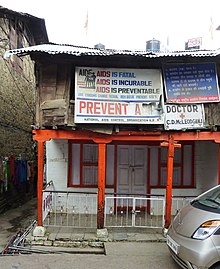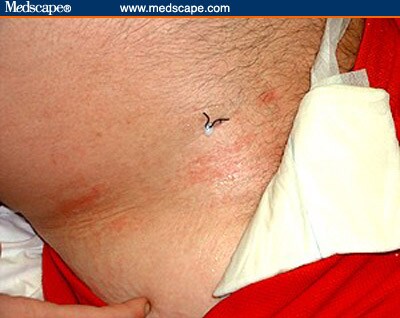http://itg.content-e.eu/Generated/pubx/173/hiv_and_aids/late_clinical_manifestations.htm
Differential diagnosis of hairy leukoplakia in HIV patients:
- Candida infection: the white lesions are not adherent and tend to be more generalized. The condition may be painful.
- Frictional keratosis from rubbing upon poorly fitting dental work or jagged teeth may appear similar but is usually unilateral.
- Squamous cell carcinoma and papillomavirus-induced neoplasia. A biopsy will confirm the diagnosis.
- Geographic tongue. In general , there are more widespread lesions on the tongue.
- Lichen planus. Look for skin lesions and Wickham's striae.
- Tobacco-associated leukoplakia
- Syphilitic mucous patch. Serology is essential for diagnosis
 | ||
Chinese Premier Wen Jiabao (C) hugs three kids, whose parents passed away due to HIV/AIDS, in Fuyang prefecture, east China's Anhui Province, Nov. 29, 2008. Wen visited people living with HIV/AIDS and workers dealing with the disease in Fuyang over the weekend, prior to the World AIDS Day which falls on December 1. (Xinhua/Rao Aimin)Photo Gallery>>>
|

An HIV-positive patient waits for treatment in Yunnan AIDS Care Center in Kunming. Photo: IC
| AIDS Patient; Before and After photo |
Infection with this virus is thought to be lifelong, but a healthy immune system will keep the virus in check.
Many people infected with KSHV will never show any symptoms. Kaposi's sarcoma occurs when someone who has been infected with KSHV becomes immunocompromised due to AIDS, medical treatment or very rarely aging.
Since persons infected with KSHV will asymptomatically shed the virus, caution should be used by sex partners in having unprotected sex and activities where saliva might be shared during sexual activity.
Prudent advice is to use commercial lubricants when needed and avoid deep kissing with partners with KSHV and HIV infections or whose status is unknown.
Blood tests to detect infection exist, but they are largely restricted to research universities, since biomedical companies have not found it economical to develop these tests.
One recent case study is acquired immune deficiency syndrome (AIDS), so-named because most syndromal immune deficiencies are inborn genetic disorders, rather than something that a previously healthy person can acquire. AIDS was originally termed "gay-related immune deficiency" (GRID), a name revised as the disease turned out to also affect heterosexuals. Several years passed after the recognition of AIDS before HIV (human immunodeficiency virus) was first described, finally explaining the hitherto mysterious "syndrome".



AIDS Clinic, McLeod Ganj, Himachal Pradesh, India, 2010
Based on these studies, the World Health Organization and UNAIDS both recommended male circumcision as a method of preventing female-to-male HIV transmission in 2007.[86] Whether it protects against male-to-female transmission is disputed[87][88] and whether it is of benefit in developed countries and amongmen who have sex with men is undetermined.[89][90][91] Some experts fear that a lower perception of vulnerability among circumcised men may cause more sexual risk-taking behavior, thus negating its preventive effects.[92]
Programs encouraging sexual abstinence do not appear to affect subsequent HIV risk.[93] Evidence for a benefit from peer education is equally poor.[94] Comprehensive sexual education provided at school may decrease high risk behavior.[95] A substantial minority of young people continues to engage in high-risk practices despite knowing about HIV/AIDS, underestimating their own risk of becoming infected with HIV.[96] It is not known whether treating other sexually transmitted infections is effective in preventing HIV.[42]
Left to right: the African green monkey source of SIV, thesooty mangabey source of HIV-2 and the chimpanzeesource of HIV-1
There is evidence that humans who participate in bushmeatactivities, either as hunters or as bushmeat vendors, commonly acquire SIV.[192] However, SIV is a weak virus which is typically suppressed by the human immune system within weeks of infection. It is thought that several transmissions of the virus from individual to individual in quick succession are necessary to allow it enough time to mutate into HIV.[193] Furthermore, due to its relatively low person-to-person transmission rate, SIV can only spread throughout the population in the presence of one or more high-risk transmission channels, which are thought to have been absent in Africa before the 20th century.
Specific proposed high-risk transmission channels, allowing the virus to adapt to humans and spread throughout the society, depend on the proposed timing of the animal-to-human crossing. Genetic studies of the virus suggest that the most recent common ancestor of the HIV-1 M group dates back to circa 1910.[194] Proponents of this dating link the HIV epidemic with the emergence of colonialism and growth of large colonial African cities, leading to social changes, including a higher degree of sexual promiscuity, the spread ofprostitution, and the accompanying high frequency of genital ulcer diseases (such as syphilis) in nascent colonial cities.[195] While transmission rates of HIV during vaginal intercourse are low under regular circumstances, they are increased many fold if one of the partners suffers from a sexually transmitted infection causing genital ulcers. Early 1900s colonial cities were notable due to their high prevalence of prostitution and genital ulcers, to the degree that, as of 1928, as many as 45% of female residents of eastern Kinshasa were thought to have been prostitutes, and, as of 1933, around 15% of all residents of the same city had syphilis.[195]
---------------ex;
This 29-year-old man developed new-onset ascites while in hospital.
The patient has HIV infection, first diagnosed in 1994. He has been poorly compliant with his highly active antiretroviral therapy (HAART) medications, which were started 3 years ago. He was also previously prescribed prophylaxis for Pneumocystis carinii pneumonia (PCP) and Mycobacterium aviumcomplex (MAC) infections. These latter medications were not taken regularly. A recent CD4+ cell count was 42 cells/mcL and HIV viral load was > 500,000 copies/mL.
Two weeks before admission the patient developed progressive shortness of breath associated with fever, dry cough, and loss of appetite. He presented to hospital and underwent evaluation. Findings on chest radiograph and sputum smear were diagnostic of PCP. He was treated with high-dose trimethoprim-sulfamethoxazole and prednisone. His respiratory status improved slowly. However, by the end of the 10th hospital day, he had developed significant ascites; gastroenterology consultation was requested.
The patient had no prior episodes of ascites or abdominal distension. He had no prior liver, cardiac, or renal disease. There was no nausea, vomiting, abdominal pain, or change in bowel habits. PPD (response to purified protein derivative tuberculin) 1 year ago was negative. He denied alcoholism, but drank 2-3 glasses of gin per day. His last use of crack cocaine and marijuana was about 6 months ago. There was no history of intravenous-drug use.
 |
| AIDS Patient with PCP |
His pulse was 90 beats per minute; blood pressure, 121/70 mm Hg; respirations, 18 breaths per minute; and temperature, 102° F. There was no palmar erythema, spider angiomata, or scleral icterus. The peripheral pulses were normal. The lungs had persistent rales, but these were reported improved since admission. The cardiac examination was normal. The abdomen was mildly distended, mildly tense, without mass or tenderness. The flanks were bulging. The liver was felt 3 cm below the right costal margin in the midclavicular line; there was no hepatic mass or tenderness. The spleen was not palpable. Paracentesis had been performed and fluid of unusual color was oozing from the puncture site (Figure 1).

